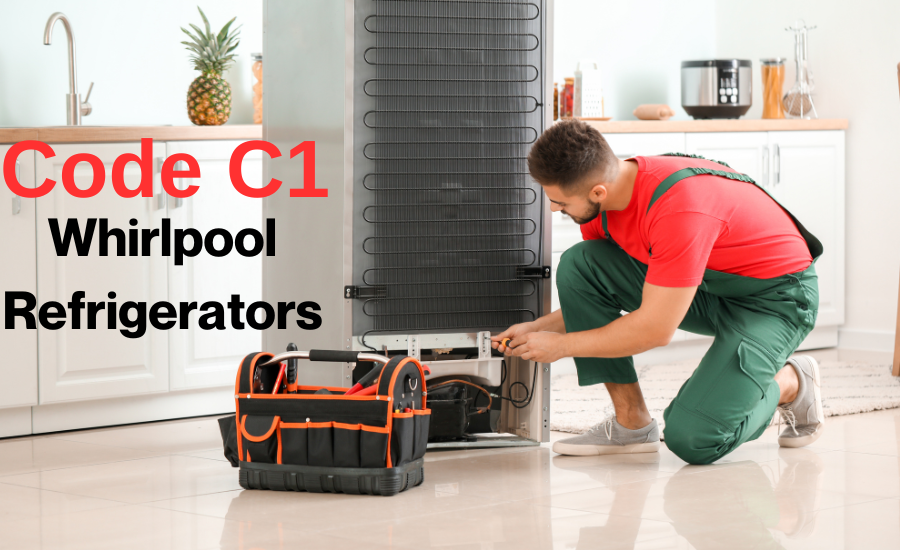Understanding Code C1: Unusual Noise or Buzzing in Whirlpool Refrigerators
In this article, we’ll take a look at what the C1 error in Whirlpool refrigerators means, its potential causes, and practical solutions you can try at home. We will also determine whether you need to contact a home appliance repair.
Introduction to Whirlpool Refrigerators
Whirlpool is one of the most trusted names in home appliances, and their refrigerators are no exception. Known for innovative designs, energy efficiency, and superior performance, Whirlpool fridges are a staple in many homes. But even the best appliances aren’t immune to occasional issues.
One common problem Whirlpool refrigerator owners may face is the C1 error code, which indicates unusual noise or buzzing. This noise can be concerning, but it doesn’t always signal a major problem. In many cases, it’s something you can easily diagnose and fix on your own.
What is a C1 Error Code?
The C1 error code in a Whirlpool refrigerator is directly related to unusual noises, particularly buzzing or humming sounds coming from the unit. This code is a signal that something in the refrigerator’s mechanical system isn’t functioning as it should. The noise could be coming from various parts, such as the compressor, condenser fan, or other components involved in cooling and airflow.
Understanding what the C1 code means is the first step in troubleshooting and resolving the issue. It’s important to pay attention to when the noise occurs (constantly or intermittently) and where it seems to be coming from.
Common causes of error code C1
Problems with the compressor
Obstructions in the path of the fan blades
Defective components
How to Diagnose the C1 Error Code
Before attempting any fixes, it’s crucial to correctly diagnose the source of the C1 error. Here’s a simple process to follow:
- Listen Carefully: Determine when and where the noise is occurring. Does it happen during certain cycles, like when the compressor is running, or is it constant?
- Inspect Key Areas: Check around the compressor, condenser fan, and evaporator fan for obvious signs of trouble, such as loose parts or debris.
- Check the Error Code History: Some Whirlpool models allow you to check the error code history, which might provide additional clues.
By following these steps, you can narrow down the source of the issue before diving into repairs.
Step-by-step troubleshooting of error C1
Now that you’ve identified the problem areas, it’s time to start troubleshooting. Below are some specific steps you can take to resolve the C1 error code.
Check the compressor
The compressor is one of the most important parts of your refrigerator, so start by checking it:
- Turn off the refrigerator and unplug it from the power supply.
- Remove the back panel to gain access to the compressor.
- Check for any visible damage or unusual heat coming from the compressor.
- Listen for abnormal humming or rattling noises.
If the compressor seems to be malfunctioning or making too much noise, you may need to replace it. However, compressor replacement often requires a professional approach.
Inspecting the fan blades
Problems with the fan blades are another common cause of humming. To check the fan blades:
- Turn off the power and locate the fan (usually near the compressor).
- Check for obstructions such as ice buildup or debris caught on the blades.
- Clear any blockages and make sure the fan blades are moving freely.
If the fan is damaged or blocked, cleaning it should eliminate the noise.
Tighten loose components
Loose screws and components can cause rattling and whirring noises. Inspect all visible parts, especially around the fan and compressor, and tighten any loose components.
Unusual Noise vs. Normal Refrigerator Sounds
It’s important to note that not all refrigerator noises are a cause for concern. Some sounds are normal during regular operation, such as:
- Clicking noises when the thermostat kicks in.
- Whooshing or blowing sounds from the fan during cooling cycles.
- Gurgling sounds from refrigerant flowing through the system.
When to Call a Professional
While many of the fixes for a C1 error are DIY-friendly, there are times when professional help is necessary. Call a technician if:
- The compressor is severely damaged.
- You’re unsure about handling electrical components.
- The noise persists even after trying the above solutions.
Max Appliance Repair is always ready to help! Give us a call at 204 202 6957.
FAQ
The C1 code indicates unusual noise or buzzing, usually caused by issues with the compressor or fan.
Yes, many C1 errors can be resolved by checking for loose components, blocked fans, or compressor issues.
Call a technician if the compressor is damaged or if the noise persists after troubleshooting.
Regular maintenance, such as cleaning condenser coils and tightening loose parts, can help prevent C1 errors.

